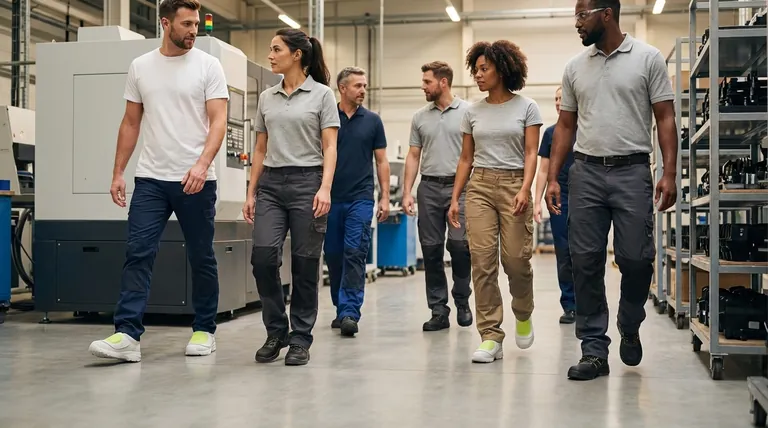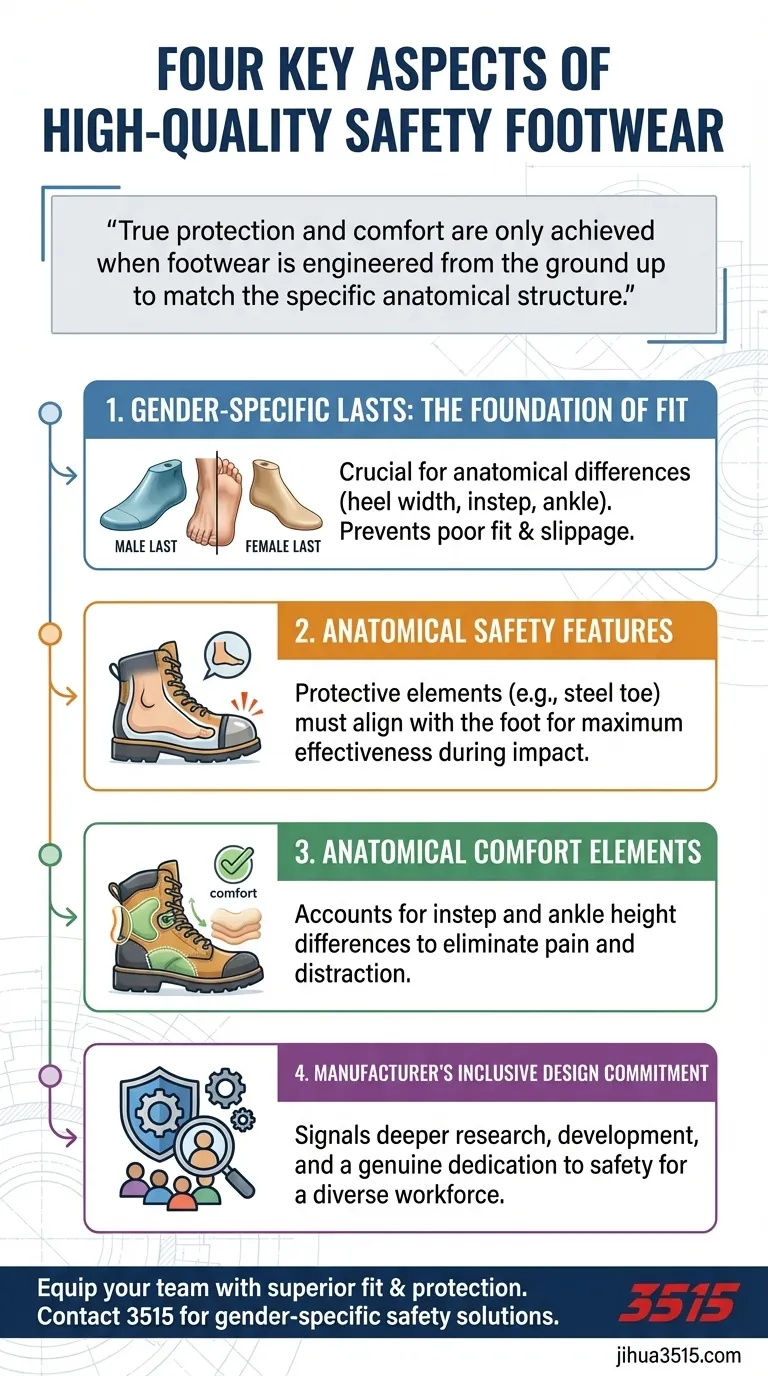Choosing the right safety footwear goes far beyond simple size selection. To ensure genuine safety and all-day wearability, you must evaluate four critical aspects: the use of gender-specific lasts for a true anatomical fit, safety features adapted to the wearer's foot structure, comfort elements that account for anatomical differences, and the manufacturer's genuine commitment to inclusive design.
The traditional "unisex" or "shrink it and pink it" approach to safety footwear is fundamentally flawed. True protection and comfort are only achieved when the footwear is engineered from the ground up to match the specific anatomical structure of the wearer's foot, not just their shoe size.

The Foundation of Fit: Why Gender-Specific Lasts Matter
The single most important factor in footwear quality is the "last"—the three-dimensional model around which a shoe is constructed. Using a last designed for the correct anatomy is non-negotiable.
What is a Shoe Last?
A shoe last is the solid, foot-shaped form that dictates the footwear's internal volume, shape, and overall fit. It is the foundational blueprint for the entire piece of footwear.
Key Anatomical Differences
On average, male and female feet differ in more than just length and width. Key distinctions include a narrower heel in relation to the forefoot, a higher instep, and different ankle bone heights in female feet.
The Failure of Down-Sizing
Simply making a smaller version of a boot built on a men's last fails to accommodate these anatomical differences. This results in poor fit, excessive heel slippage, and improper support, which directly compromises both safety and comfort.
Adapting Safety and Comfort to Anatomy
Protective features are only effective if they are correctly positioned on the foot. A proper anatomical fit ensures that safety components and comfort systems work as intended.
Safety Features Aligned with the Foot
A steel toe or composite cap must be shaped and placed to align with the wearer's foot. A boot that is too wide in the heel allows the foot to slide forward, potentially misaligning the toes with their primary protective element during an impact.
How Fit Impacts Stability
Anatomically correct design prevents the foot from moving excessively inside the boot. This stability is crucial for preventing slips, trips, and falls, particularly on uneven surfaces.
Comfort as a Critical Safety Element
Discomfort is a distraction. Footwear that doesn't account for differences in instep or ankle height can cause painful rubbing and pressure points. A worker who is distracted by pain is less focused on their tasks and the potential hazards around them.
Understanding the Trade-offs of a Poor Fit
Opting for poorly fitting, one-size-fits-all footwear creates significant risks that extend beyond simple discomfort. Understanding these consequences is key to making an informed decision.
The Illusion of Cost Savings
Lower-cost, "unisex" boots often lead to higher long-term expenses. These can include lost productivity due to employee discomfort, increased injury-related costs, and the need for more frequent replacement.
The Risk of Non-Compliance
If safety footwear is uncomfortable, workers are less likely to wear it correctly or may even remove it when they feel unobserved. The best safety boot is the one that is actually worn.
Long-Term Health Consequences
Wearing improperly fitted footwear day after day can contribute to chronic musculoskeletal issues. Problems like plantar fasciitis, bunions, and even lower back pain can arise from a lack of proper anatomical support.
Evaluating a Manufacturer's Commitment
A manufacturer's philosophy on diversity and inclusion is a strong indicator of product quality. Companies that invest in creating distinct product lines demonstrate a deeper understanding of occupational safety.
Look for Genuine Design
Go beyond marketing claims. Look for brands that explicitly state their footwear is built on a gender-specific last. This terminology signals a true commitment to anatomical design.
A Sign of Deeper Expertise
A manufacturer dedicated to serving a diverse workforce is more likely to have invested the necessary research and development to create a genuinely superior and safer product for everyone. This commitment to inclusion reflects an overall commitment to quality.
How to Select the Right Footwear
Use these principles to guide your selection process, whether you are buying for yourself or for an entire team.
- If your primary focus is individual safety and comfort: Seek out brands that explicitly market distinct men's and women's lines and confirm they are built on gender-specific lasts.
- If your primary focus is outfitting a diverse team: Prioritize suppliers who demonstrate a clear commitment to inclusive design and can provide detailed fit guides for their anatomically-correct product lines.
Ultimately, investing in footwear designed for the wearer's anatomy is a direct investment in their safety, health, and well-being.
Summary Table:
| Key Aspect | Why It Matters |
|---|---|
| Gender-Specific Lasts | Ensures anatomical fit, prevents heel slippage and misaligned safety features. |
| Anatomical Safety Features | Guarantees protective elements like steel toes are correctly positioned for maximum effectiveness. |
| Anatomical Comfort Elements | Reduces pain and distraction by accommodating differences in instep and ankle height. |
| Manufacturer's Inclusive Design | Signals a deeper commitment to quality, safety, and serving a diverse workforce. |
Ready to equip your team with safety footwear engineered for superior fit and protection?
As a large-scale manufacturer, 3515 produces a comprehensive range of safety footwear for distributors, brand owners, and bulk clients. Our production capabilities encompass all types of safety shoes and boots, built on gender-specific lasts to ensure genuine anatomical comfort and protection for every worker.
We help you enhance workplace safety, boost productivity by reducing discomfort, and demonstrate a true commitment to your team's well-being.
Contact 3515 today to discuss your specific needs and discover the right safety solution for your workforce.
Visual Guide

Related Products
- Customizable Slip-On Safety Shoes Direct from the Factory for Wholesale
- Wholesale Customizable Suede Safety Boots - Puncture-Proof with Velcro Closure
- Wholesale Durable Camo Canvas Shoes with High-Traction Rubber Soles
- Customizable Anti-Smash Safety Boots for Wholesale & Private Label Manufacturing
- Athletic Safety Shoes with Dial Closure & Steel Toe for Wholesale & Custom Manufacturing
People Also Ask
- How does toe box design differ between men's and women's work boots? Fit for a Woman's Foot Anatomy
- What regular maintenance checks should be performed on safety boots? A Daily Safety Checklist
- What is the purpose of ASTM International? A Guide to Global Quality Standards
- Is it normal to wear shoes in the house? A Guide to Hygiene, Comfort & Culture
- What are the potential consequences of wearing improperly designed work boots? Avoid Injury & Boost Safety



















